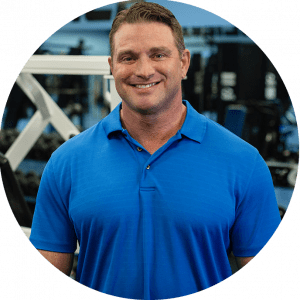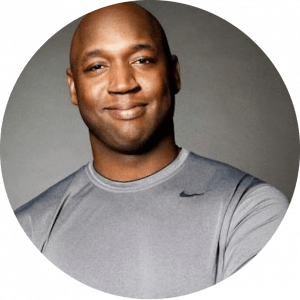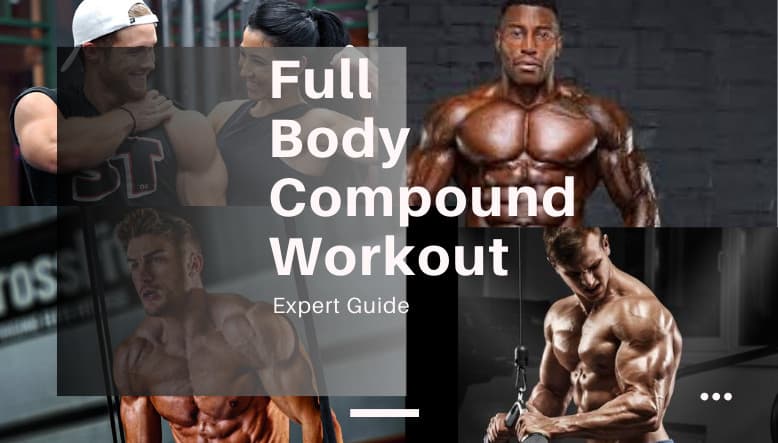
The basic idea behind full body compound workouts is that you target the whole body (as opposed to focusing on specific areas) and use exercises which target multiple muscles (as opposed to exercises which only target one specific muscle). If you have limited time (or inclination) to go to the gym, you can use full body compound exercises on their own as a complete fitness programme. Alternatively you can mix and match them with “part days”, e.g. leg days, on which you do isolation exercises.

Balancing Full-Body Compound Exercises and Rest
We’d suggest that you learn a range of full-body compound exercises so that you can put together two or three different workouts (for variety). You’d then schedule your full body compound workouts so you have a workout followed by a rest day and an extra rest day every third workout.
That means if you can put together three workouts, then you have a complete routine you can use for as long as suits you. If you can only put together two then just keep alternating them. You’ll end up doing the same workout twice a week, but over the course of two weeks, this will balance itself out.

The Best Full Body Compound Exercises
Here’s what we think are the seven best full body compound exercises and why.
Bench Press
The bench press is generally performed with a barbell, but we recommend dumbbells. The reason for this is that most people have a “strong” side and a “weak” side and if you use a barbell, then you may find yourself doing most of the work with the side which is already stronger. If you use dumbbells, then you’re basically forced to use each shoulder equally.
If you want to bench press successfully (i.e. without injury) then you must keep your shoulders in their sockets. The usual way to do this is to start with a completely flat back and then arch your top back slightly to help your shoulders tuck in while keeping your butt on the bench.
Start with your elbows bent so that your forearms are upright and by your shoulders. Raise the weights until your arms are almost straight, but not locked. Breathe deeply in and out and then lower the dumbbells slowly. Keep your shoulders as tucked in as you can. If they’re at right angles to your body they’re too wide and you’re using your arms not your chest.
Bent-over row
This is another exercise which is generally performed with a barbell, but we prefer dumbbells for the same reason as for the bench press.
The basic idea behind a bent-over row is that you stand with your feet shoulder-width apart, your knees slightly bent and your upper chest over your knees. This means that your butt will be behind your feet and your back slightly bent. In fact, your upper legs and torso should make a right angle (at least approximately).
For this one you start with your arms almost straight, so the dumbbells are in front of your knees. Then you bend your arms back so that the dumbbells come alongside your body, with the result that your elbows are at an approximate right angle. Your back must stay straight and neutral and your elbows stay tucked in. You’re simulating a rowing action, not a bird flapping its wings.
All versions of the bent-over row target the back and upper legs. Again, you can learn different forms of this exercise to target different muscle groups, albeit within the same body area.
Deadlifts
Deadlifts use your entire posterior chain. This means two things. First of all, you can really build strength with it. Secondly, you can do yourself serious damage if you get it wrong. Don’t mess about with deadlifts. Ideally get someone to teach it to you. As a minimum get a good video and study it carefully.
Dumbbell Shoulder Press
Again, you can do this exercise with a barbell, but we recommend dumbbells for the same reason as with the bench press and the bent-over row.
The mechanics of this exercise are actually pretty simple. Hold a dumbbell in each hand. Bend your elbows and move your forearms up so the dumbbells are level with your shoulders. Keep the palms of you hands facing forwards and by your sides so that the dumbbells are in a straight line with your shoulders. Straighten your arms as far as you can without locking your elbows, then return, slowly, to the starting position.
Choose your weights with care. You want to start out feeling that you’ve picked weights which are really a bit too light for you. Once you’ve done a few reps, however, you’ll start to feel the effect and be glad you didn’t overload yourself.
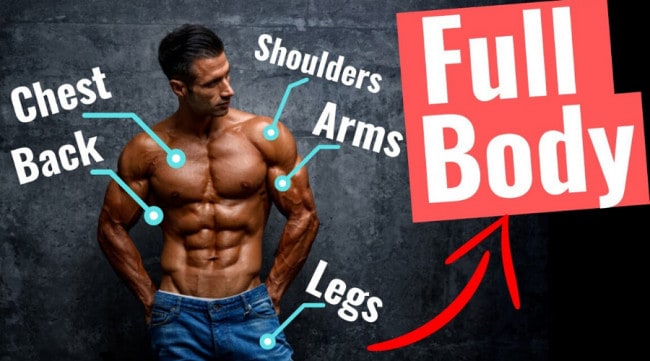
Lying Dumbbell Hamstring Curls
Leg curls are probably most associated with machines, but you can do them just on a bench or on the floor. Some people prefer an elevated bench because it facilitates a wider range of movement, but if you’re just looking for a straightforward compound exercise to use as part of a full body compound workout, then you’ll be just fine lying on the floor.
Just hold the dumbbell between your feet and raise your lower legs legs until they are at a right angle with your body. Then lower them again, slowly. You can keep your face flat on the floor (rested on your hands) or lean on your elbows, whichever you find most comfortable. Keep your back straight and neutral and never let your knees lock.
Pull-Ups or Push-Ups
Pull-ups are a standard gym exercise and they’re great for the arms and upper back. They do, however, require a bar (or a machine so they may not be feasible for anyone doing a full body compound workout at home, especially if you’re renting. If that sounds like you, then push-ups are a good alternative. They target similar muscles. Both exercises are so well-known, we don’t think anyone will need a walk-through, but if you do, there are plenty of good YouTube videos.
Squats
Squats stress a lot of muscles, so even though they’re last on our main list, it’s generally a good idea to do them early in your workout before you start hitting real fatigue.
The beginner’s version of squats is just to stand against a wall, feet shoulder-width apart, and bend your knees as far as you comfortably can. Keep your back straight and neutral. Stop before you reach a full crouch and if you feel your knees locking then come out of the squat immediately.
Even though this is described as the beginner version of squats, it’s actually very effective and you could use it indefinitely if you wanted to. Alternatively, if you think variety is the spice of life, here are some ways you could make your life more interesting (read tougher).
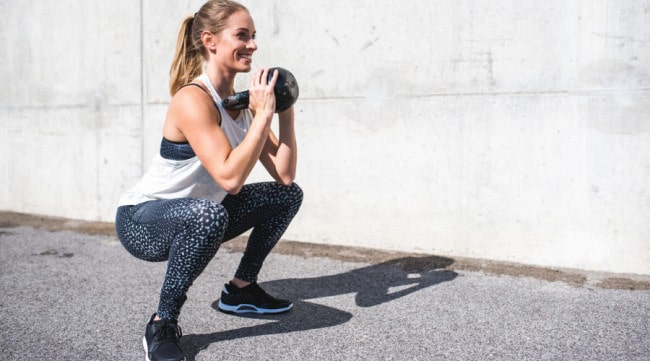
Goblet squats
As above but add a kettlebell.
High-bar squats and low-bar squats
High-bar squats use a barbell placed high on the trapezius muscle across the top of the shoulders. Low-bar squats have the barbell low on the upper back. The high-bar squat gives all the leg muscles a fairly even workout, which is why bodybuilders love it. The low-bar squat puts more of the weight goes onto the glutes and hamstrings, but it is a more stable position, which means you can usually use heavier weights.
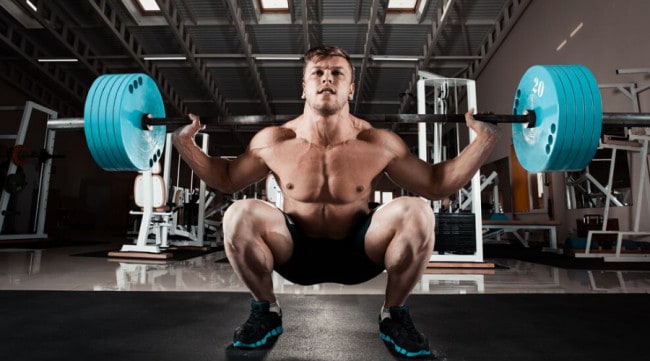
Front squats
Basically, high-bar squats but with the weight at the front. This really works the quads.
There are actually all kinds of further variations of squats you could try if you really get into them. Just look them up online.
Bonus - Best Exercises For Forearms
We all know that we need to think about our bodies as a whole, but, let’s be honest, the weather in the UK being what it is, most of the time, most of our bodies are hidden under warm clothes. Our forearms, however, can be on display at any time of the year, so it’s worth giving them a little extra love. With that in mind, here is our pick of the best exercises for forearms.
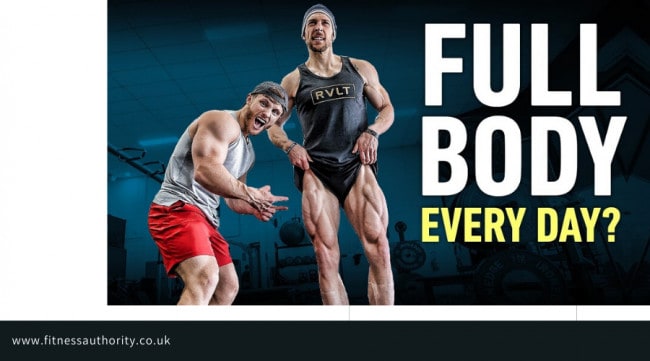
Farmer’s Walks
The mechanics of this one are about as easy as you can get. Just pick up a weight in each hand and walk about a space. Keep your back straight and neutral and your shoulders back and down, not hunched or shrugged. You may find this exercise more comfortable with proper farmer’s walk handles but many people just use dumbbells as that’s what everyone has. Be sensible about the weight, in other words, err on the side of lightness, you can always add extra weight later if you really think it’s too easy.
Wrist curls
Hold the dumbbell with an underhand grip and rest your arms on your legs (or a bench) so that you have support down to about the middle of your forearm. Then push your wrists to their lowest point and contract them to their highest. Start with minimal weight and add more if you want to but be very careful because the whole point of this exercise is to engage your wrists and your wrists only. If you pile on the weight you will be at a very high risk of injuring yourself.
Wrist grips
Wrist grips are a piece of equipment as well as an exercise. Usually we try to avoid recommending any exercise which requires you to buy an extra piece of equipment, but this forearm exercise is so good we’re making an exception. Just buy your wrist grip (they’re affordable and small, so easy to store, in fact you could carry one in your pocket to workout on the go) and squeeze whenever you want for as many reps as you want. That’s it. There’s basically no way you can injure yourself.
Conclusion
So there you go, we’ve given you seven exercises for your core body, arms and legs, plus a bonus three exercises for your forearms. None of them require machines. You just need a barbell (and a couple of weight plates), a couple of dumbbells, maybe a kettlebell, and a wrist grip. That means most people will be able to perform these exercises at home if they can’t get to a gym (or don’t want to go to a gym).
Jeff is a medium-sized private gym owner that has itself over 100 members and is our equipment reviewer. If it builds muscle, gets you fit or pretends to be healthy, Jeff knows all about it. Worked with Fitness Superstore as a buyer for 10 years. Seriously BIG guy with a heart to match. Always laughing and looking for a windup. Literally always eating

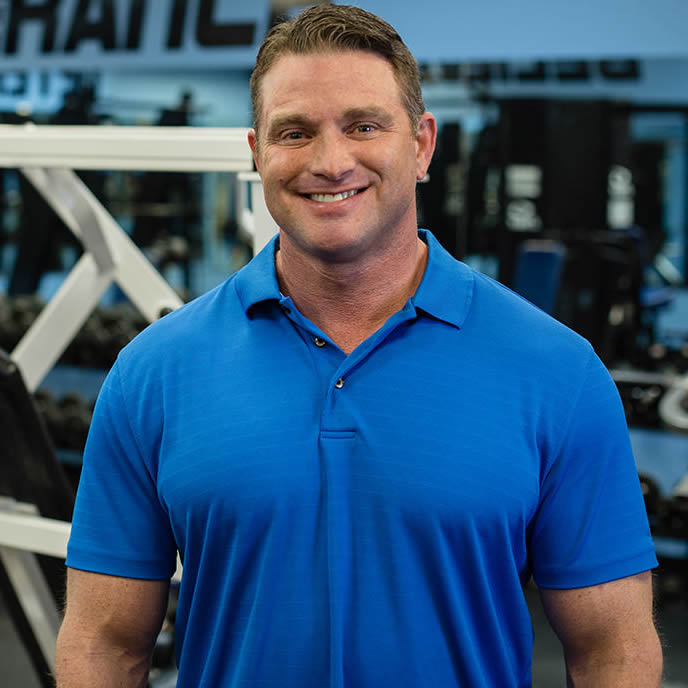
![Full Body Compound Workout [Expert Guide]](https://fitnessauthority.co.uk/wp-content/uploads/thumbs_dir/Best-Snooker-Cue-Uk-Buyers-Guide1-omsnlydo04lguqo10ft6920ouyefnftxiy3jjyaq0s.jpg)
![Full Body Compound Workout [Expert Guide]](https://fitnessauthority.co.uk/wp-content/uploads/thumbs_dir/best-rear-delt-exercises-omykrn4iaxanfg7i2fkv1mlmzzrtbhu6k68lo8g0u4.png)






